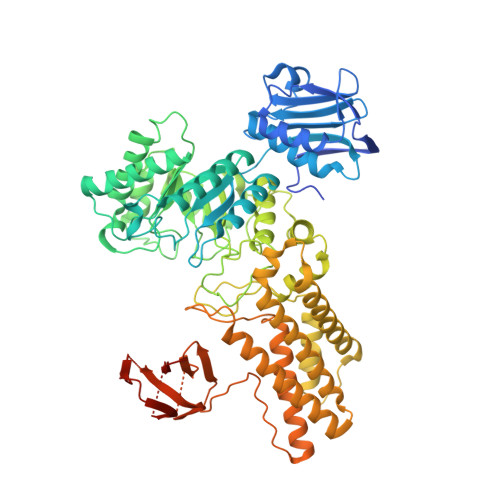A Potent Mechanism-Inspired O-Glcnacase Inhibitor that Blocks Phosphorylation of Tau in Vivo.
Yuzwa, S.A., Macauley, M.S., Heinonen, J.E., Shan, X., Dennis, R.J., He, Y., Whitworth, G.E., Stubbs, K.A., Mceachern, E.J., Davies, G.J., Vocadlo, D.J.(2008) Nat Chem Biol 4: 483
- PubMed: 18587388
- DOI: https://doi.org/10.1038/nchembio.96
- Primary Citation of Related Structures:
2VVN - PubMed Abstract:
Pathological hyperphosphorylation of the microtubule-associated protein tau is characteristic of Alzheimer's disease (AD) and the associated tauopathies. The reciprocal relationship between phosphorylation and O-GlcNAc modification of tau and reductions in O-GlcNAc levels on tau in AD brain offers motivation for the generation of potent and selective inhibitors that can effectively enhance O-GlcNAc in vertebrate brain. We describe the rational design and synthesis of such an inhibitor (thiamet-G, K(i) = 21 nM; 1) of human O-GlcNAcase. Thiamet-G decreased phosphorylation of tau in PC-12 cells at pathologically relevant sites including Thr231 and Ser396. Thiamet-G also efficiently reduced phosphorylation of tau at Thr231, Ser396 and Ser422 in both rat cortex and hippocampus, which reveals the rapid and dynamic relationship between O-GlcNAc and phosphorylation of tau in vivo. We anticipate that thiamet-G will find wide use in probing the functional role of O-GlcNAc in vertebrate brain, and it may also offer a route to blocking pathological hyperphosphorylation of tau in AD.
- Department of Molecular Biology and Biochemistry, Simon Fraser University, 8888 University Drive, Burnaby, British Columbia V5A 1S6, Canada.
Organizational Affiliation:



















